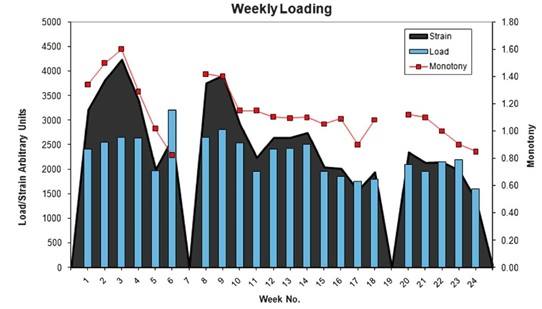作者:詹華蓁 國體大運動保健學系碩士班 資深運動防護員
延續RPE訓練衝量法的主題訓練量監控:RPE訓練衝量法(session-RPE)-1,上次只提到了 運動訓練量(Training load , TL)的部分,依據每日、每周、每個月的TL呈現,可以了解在不同週期時訓練量的變化。
文獻指出監控選手的每週運動訓練量,可以幫助體能管理與疲勞恢復監控,減少傷害的發生(Williams et al., 2017)。
除TL之外,藉由收取到每次訓練課後的數據,以不同的計算公式加以計算 (圖一),可以得到訓練同質性(Training monotony ,TM)、訓練張力值(Training strain ,TS)、週間訓練量變化(Week-to-week change ,WWC)、短期:長期訓練量比值(Acute :chronic workload ratio, ACWR)等數據。
圖一

- 訓練同質性(Training monotony, TM):為一週內每日訓練的一致性(Foster, 1998
- 訓練張力值(Training strain, TS):為選手整週訓練的整體壓力(Comyns & Flanagan, 2013)
- 週間訓練量變化(Week-to-week change ,WWC):為當週與上一週之運動訓練量的絕對差異值
研究指出突然增加的運動訓練量,將造成傷害、疾病發生風險大幅增加( Foster, 1998; Hulin et al., 2014; Piggott et al., 2009; Rogalski et al., 2013),特別是針對傷後復健過程中的選手(Blanch & Gabbett, 2016)
短期:長期訓練量比值(Acute :chronic workload ratio, ACWR)是當週與上一週之運動訓練量的相對差異值,學者們認為,ACWR可被視為類似Banister學者提出的體能與疲勞模型,但更具體的量化訓練量,藉由此參數數值呈現選手正面或是負面適應,提供教練、選手在訓練時的一個參考指標(Hulin et al., 2014),然而,目前研究運動項目較少,且受試者皆為團隊項目選手(愛爾蘭足球 (Gaelic football)、籃球、板球、澳式足球、橄欖球) (Blanch & Gabbett, 2016; Hulin et al., 2014; Hulin et al., 2016; Malone, Owen, et al., 2017; Malone, Roe, Doran, Gabbett, & Collins, 2017; Rogalski et al., 2013; Weiss, Allen, McGuigan, & Whatman, 2017),筆者長期照顧之運動專項運動 (柔道)上在去年有幾篇文獻刊登出來 (Laird & Macdonal 2017),但研究對象的樣本數偏少,因此,如要運用在個人運動專項運動上,也是可以,但建議需要配合其他指標或是其他監控方式會更好。
大家在利用此方法時,可以依據自己的需求設計圖表呈現,照片裡是筆者製作的圖表,大家可以參考看看。
圖二是文獻上TL、TM、TS三者的呈現圖

圖三是筆者自己設計的TL、TM、TS三者呈現圖版本

圖四是筆者把ACWR與TL兩項指標一同對比

圖五是週間訓練量變化的長期記錄圖

這也是告訴大家,沒有絕對一定要怎麼呈現,端看看各位在臨床應用上的需求而調整出最適合自己的呈現方式。
最後有兩事是要再提醒大家,一是:
至今尚未有一種監控工具,可以精確的量化訓練後的適應效果與疲勞反應,或是預測運動表現(Bourdon et al., 2017)
會推薦使用Session-RPE這個方式,是因為此方法為簡單、容易執行的監控方式,不但選手、教練容易理解、無侵入性,相較於其他監控方式,更容易於每日訓練收取數據,且立即能了解訓練過程的變化,也適用於長期監控。但Session-RPE畢竟是選手主觀判定得之的,因此,相關文獻建議 可搭配客觀監控工具如:全球定位系統、運動表現測試、生化指標等,一同進行訓練監控,能夠更全面了解運動員的準備狀態 (Preparedness)(Lovell, Sirotic, Impellizzeri, & Coutts, 2013)
二是
一旦建立的訓練量的監控,就必須有分析、討論與回饋修正(如圖六),且建議需與之前的數據一同分析,才能有效地理解當下數據帶來的意義。不然數字永遠只是數字而已。

註:本篇文章擷取部分筆者之發表文章 – 詹華蓁, & 江杰穎. (2017). RPE 訓練衝量法在運動訓練與監控之應用: 系統性回顧. 運動表現期刊, 4(2), 87-97.
延伸閱讀:訓練量監控:RPE訓練衝量法(session-RPE)-1
參考文獻:
1. Blanch, P., & Gabbett, T. J. (2016). Has the athlete trained enough to return to play safely? The acute: chronic workload ratio permits clinicians to quantify a player’s risk of subsequent injury. British Journal of Sports Medicine, 50(8), 471-475.
2. Bourdon, P. C., Cardinale, M., Murray, A., Gastin, P., Kellmann, M., Varley, M. C., … & Cable, N. T. (2017). Monitoring Athlete Training Loads: Consensus Statement. International Journal of Sports Physiology and Performance, 12(Suppl 2), S2-161.
3. Comyns, T., & Flanagan, E. P. (2013). Applications of the session rating of perceived exertion system in professional rugby union. Strength and Conditioning Journal, 35(6), 78-85.
4. Foster, C. (1998). Monitoring training in athletes with reference to overtraining syndrome. Medicine and science in sports and exercise, 30, 1164-1168.
5. Hulin, B. T., Gabbett, T. J., Blanch, P., Chapman, P., Bailey, D., & Orchard, J. W. (2014). Spikes in acute workload are associated with increased injury risk in elite cricket fast bowlers. British Journal of Sports Medicine, 48(8), 708-712.
6. Hulin, B. T., Gabbett, T. J., Lawson, D. W., Caputi, P., & Sampson, J. A. (2016). The acute: chronic workload ratio predicts injury: high chronic workload may decrease injury risk in elite rugby league players. British journal of Sports Medicine, 50(4), 231-236.
7. Laird, J., & Macdonald, A. (2017). Is grip strength sensitive to training load in an elite Judoka?. Physical Therapy in Sport, 28, e8.
8. Lovell, T. W., Sirotic, A. C., Impellizzeri, F. M., & Coutts, A. J. (2013). Factors affecting perception of effort (session rating of perceived exertion) during rugby league training. International journal of sports physiology and performance, 8(1), 62-69.
9. Malone, S., Owen, A., Newton, M., Mendes, B., Collins, K. D., & Gabbett, T. J. (2017). The acute: chonic workload ratio in relation to injury risk in professional soccer. Journal of Science and Medicine in Sport, 20(6), 561-565.
10. Malone, S., Roe, M., Doran, D., Gabbett, T., & Collins, K. (2016). Aerobic Fitness and Playing Experience Protect Against Spikes in Workload: The Role of the Acute: Chronic Workload Ratio on Injury Risk in Elite Gaelic Football. International journal of sports physiology and performance.
11. Piggott, B., Newton, M. J., & McGuigan, M. R. (2009). The relationship between training load and incidence of injury and illness over a pre-season at an Australian football league club. Journal of Australian Strength and Conditioning, 17(3).
12. Rogalski, B., Dawson, B., Heasman, J., & Gabbett, T. J. (2013). Training and game loads and injury risk in elite Australian footballers. Journal of Science and Medicine in Sport, 16(6), 499-503.
13. Weiss, K. J., Allen, S. V., McGuigan, M. R., & Whatman, C. S. (2017). The Relationship Between Training Load and Injury in Men’s Professional Basketball Players. International journal of sports physiology and performance, 1-20.
14. Williams, S., Trewartha, G., Cross, M. J., Kemp, S. P., & Stokes, K. A. (2017). Monitoring What Matters: A Systematic Process for Selecting Training-Load Measures. International journal of sports physiology and performance, 12(Suppl 2), S2-101

[…] 延伸閱讀:訓練量監控:RPE訓練衝量法(session-RPE)-2 […]
讚讚